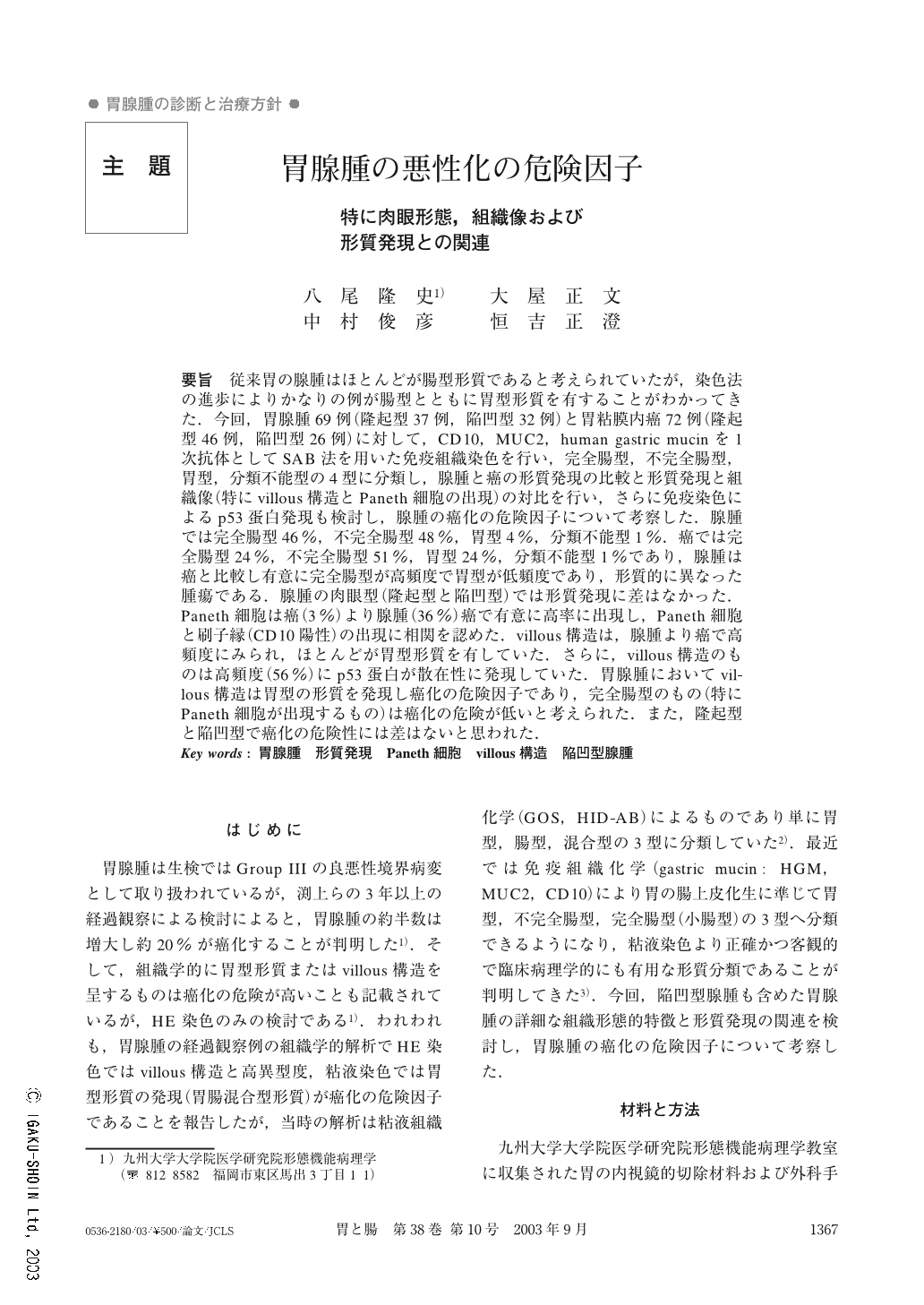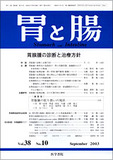Japanese
English
- 有料閲覧
- Abstract 文献概要
- 1ページ目 Look Inside
- 参考文献 Reference
- サイト内被引用 Cited by
要旨 従来胃の腺腫はほとんどが腸型形質であると考えられていたが,染色法の進歩によりかなりの例が腸型とともに胃型形質を有することがわかってきた.今回,胃腺腫69例(隆起型37例,陥凹型32例)と胃粘膜内癌72例(隆起型46例,陥凹型26例)に対して,CD10,MUC2,human gastric mucinを1次抗体としてSAB法を用いた免疫組織染色を行い,完全腸型,不完全腸型,胃型,分類不能型の4型に分類し,腺腫と癌の形質発現の比較と形質発現と組織像(特にvillous構造とPaneth細胞の出現)の対比を行い,さらに免疫染色によるp53蛋白発現も検討し,腺腫の癌化の危険因子について考察した.腺腫では完全腸型46%,不完全腸型48%,胃型4%,分類不能型1%.癌では完全腸型24%,不完全腸型51%,胃型24%,分類不能型1%であり,腺腫は癌と比較し有意に完全腸型が高頻度で胃型が低頻度であり,形質的に異なった腫瘍である.腺腫の肉眼型(隆起型と陥凹型)では形質発現に差はなかった.Paneth細胞は癌(3%)より腺腫(36%)癌で有意に高率に出現し,Paneth細胞と刷子縁(CD10陽性)の出現に相関を認めた.villous構造は,腺腫より癌で高頻度にみられ,ほとんどが胃型形質を有していた.さらに,villous構造のものは高頻度(56%)にp53蛋白が散在性に発現していた.胃腺腫においてvillous構造は胃型の形質を発現し癌化の危険因子であり,完全腸型のもの(特にPaneth細胞が出現するもの)は癌化の危険が低いと考えられた.また,隆起型と陥凹型で癌化の危険性には差はないと思われた.
Most gastric adenomas used to be considered to express an intestinal phenotype, but recent advances in stain methods have revealed that some of them expressed not only an intestinal but also a gastric phenotype. Sixty-nine gastric adenomas (polypoid 37, depressed 32) and 72 intramucosal carcinomas (polypoid 46, depressed 26) were used for this study. According to the classification of intestinal metaplasia, their phenotypes were classified into four categories : complete intestinal type (C-type), incomplete intestinal type (I-type), gastric type (G-type) and unclassified type (U-type), based on the combination of the expression of CD10 (small intestinal brush border), MUC2 (intestinal goblet cell) and HGM (gastric foveolar epithelium).
Adenomas were classified into 46% of C-type, 48% of I-type, 4% of G-type and 1% of U-type. Carcinomas were classified into 24% of C-type, 51% of I-type, 24% of G-type and 1% of U-type. Incidence of C-type was higher in adenomas than in carcinomas, and incidence of G-type was lower in adenomas than in carcinomas. There was no difference in phenotypic expression between polypoid and depressed ones. Paneth cells, which are associated with CD10 expression, are more frequently present in adenomas (36%) than in carcinomas (3%). Adenomas with a villous structure expressed a gastric phenotype, and 56% of them sporadically expressed p53 protein.
Adenomas with a villous structure, which are associated with a gastric phenotype, are considered to have a higher risk of malignant transformation. Those of C-type, especially with Paneth cells, are considered to have a lower risk of malignant transformation. In addition, there seems to be no difference in risk of malignant transformation between polypoid and depressed adenomas.

Copyright © 2003, Igaku-Shoin Ltd. All rights reserved.


